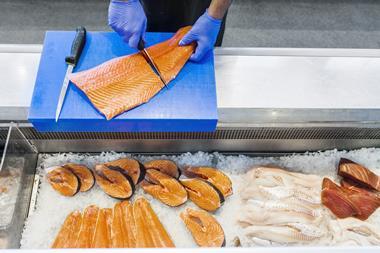SALMON
As the Alaskan red salmon season comes to an end, there is frantic activity at the government inspection facilities to get the gradings completed. All product has to go through a rigorous process to ensure both quality and integrity is assured. UK brand distributors have their own independent inspectors in Seattle to ensure maintenance of specifications. "The fish were smaller than normal but the colour is better than average," said one inspector.
The pack, split by sizes, is different to last season with more 213g and 105g, but 418g are down by 25%. Early price indications from some smaller packers suggest that 213g will be 5% higher, 105g unchanged and 418g 10% up. A favourable exchange rate will alleviate some of the increase, but canners will press for higher prices to cover fuel costs (up 100%) and the inevitable tin plate increases.
Promotional activity will revert to the traditional 213g, whereas last season an excess of 418g resulted in some bogof deals for the first time. "We feel more confident with the 213g offer as consumers are less inclined to purchase two cans of 418g in spite of the fact that one of them is free," said an importer.
Pink salmon will be a real problem this season as the catch is clearly of disastrously low volume. The UK is primarily a red market, but during the past two years large pink packs have resulted in a spate of bogofs, raising consumer awareness of the grade. No prices have yet been announced but early indications suggest that 213g will be 40%-50% higher than last year. "At these levels we just don't see any chance of repeating traditional volumes, so the recent efforts to stimulate interest will be wasted," an importer said.
Canners who depend on pink salmon, mainly outside the Bristol Bay red catchment area, face big losses. After some years of abundance, no-one expected a 70% drop in fish numbers. The fear is that the red run could face the same fate some time in the future.
PEACHES
News from Greece worsens as latest predictions put the peach crop at 40% of last year's volume. Spain has a reasonable crop, but the additional demand has forced canners to withdraw all offers. There may be problems over contracts that were taken before the extent of the shortfall was known.
Spanish processors struck low-cost raw material contracts with growers resulting in farmers switching back to the more lucrative fresh market. "We have contracts with growers who are not delivering the fruit and we will be forced to reduce production," a Murcian canner said.
As the Alaskan red salmon season comes to an end, there is frantic activity at the government inspection facilities to get the gradings completed. All product has to go through a rigorous process to ensure both quality and integrity is assured. UK brand distributors have their own independent inspectors in Seattle to ensure maintenance of specifications. "The fish were smaller than normal but the colour is better than average," said one inspector.
The pack, split by sizes, is different to last season with more 213g and 105g, but 418g are down by 25%. Early price indications from some smaller packers suggest that 213g will be 5% higher, 105g unchanged and 418g 10% up. A favourable exchange rate will alleviate some of the increase, but canners will press for higher prices to cover fuel costs (up 100%) and the inevitable tin plate increases.
Promotional activity will revert to the traditional 213g, whereas last season an excess of 418g resulted in some bogof deals for the first time. "We feel more confident with the 213g offer as consumers are less inclined to purchase two cans of 418g in spite of the fact that one of them is free," said an importer.
Pink salmon will be a real problem this season as the catch is clearly of disastrously low volume. The UK is primarily a red market, but during the past two years large pink packs have resulted in a spate of bogofs, raising consumer awareness of the grade. No prices have yet been announced but early indications suggest that 213g will be 40%-50% higher than last year. "At these levels we just don't see any chance of repeating traditional volumes, so the recent efforts to stimulate interest will be wasted," an importer said.
Canners who depend on pink salmon, mainly outside the Bristol Bay red catchment area, face big losses. After some years of abundance, no-one expected a 70% drop in fish numbers. The fear is that the red run could face the same fate some time in the future.
PEACHES
News from Greece worsens as latest predictions put the peach crop at 40% of last year's volume. Spain has a reasonable crop, but the additional demand has forced canners to withdraw all offers. There may be problems over contracts that were taken before the extent of the shortfall was known.
Spanish processors struck low-cost raw material contracts with growers resulting in farmers switching back to the more lucrative fresh market. "We have contracts with growers who are not delivering the fruit and we will be forced to reduce production," a Murcian canner said.









No comments yet